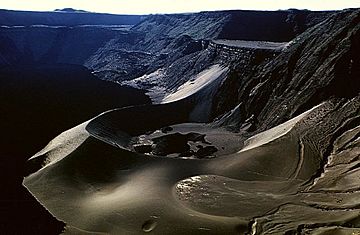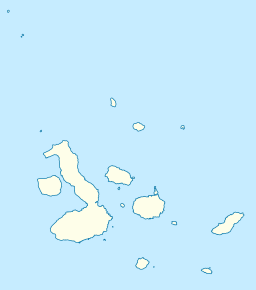Cerro Azul (Ecuador volcano) facts for kids
Quick facts for kids Cerro Azul |
|
|---|---|

A large tuff cone occupying the east-northeast side of summit caldera
|
|
| Highest point | |
| Elevation | 1,689 m (5,541 ft) |
| Prominence | 1,668 m (5,472 ft) |
| Listing | Ultra |
| Geography | |
| Location | Isabela Island, Galápagos Islands, Ecuador |
| Geology | |
| Mountain type | Shield volcano |
| Last eruption | 29 May – 17 June 2008 |
Cerro Azul means Blue Hill in Spanish. It's a huge shield volcano located on the southwestern part of Isabela Island. This island is part of the famous Galápagos Islands.
Standing at 1,689 m (5,541 ft), Cerro Azul is the second tallest peak in the Galapagos. It's also known as an ultra because it rises so much higher than the land around it. This volcano is very active, with its most recent eruption happening in 2008.
Contents
What is Cerro Azul's Geology Like?
The Galapagos Islands were formed by something called a mantle plume. Imagine a super hot spot deep inside the Earth. This "hotspot" pushes up melted rock, creating volcanoes and islands. It's similar to how the Hawaiian islands were made.
Cerro Azul sits on the edge of this hot spot. To its west, the ocean floor drops very steeply. But to the east of Isabela Island, the sea is much shallower.
How is Cerro Azul Shaped?
Cerro Azul is one of six large volcanoes that are close together on Isabela Island. The others are Ecuador, Wolf, Darwin, Alcedo, and Sierra Negra.
Cerro Azul looks a bit like a giant, upside-down soup bowl. Like other volcanoes on Isabela Island, it has a huge crater at its top called a caldera. Cerro Azul's caldera is about 4 by 5 kilometers wide. It's one of the smaller calderas there.
This caldera has collapsed several times after eruptions. It's very deep, reaching 450 to 650 meters below the rim. Only Wolf Volcano in the Galapagos has a caldera that is as deep.
The volcano itself is about 34 kilometers long and 22 kilometers wide. Its sides are quite steep, sloping between 12 and 30 degrees. The western side of the volcano slopes sharply down into the deep ocean.
When Did Cerro Azul Erupt?
Cerro Azul has erupted many times throughout history. The first recorded eruption was in 1932. Since then, it has been active in 1940, 1943, 1949, 1951, 1959, 1968, 1979, 1998, and most recently in 2008.
Scientists believe the surface of the volcano is quite young, less than 5,000 years old. However, the volcano itself is estimated to be around 350,000 years old.
The 2008 eruption started in May. During this eruption, cracks opened on the volcano's southeast side, letting lava flow out. The 1998 eruption also had lava flowing from similar cracks. The lava from these cracks traveled about 10 km (6 mi). There was also an eruption inside the caldera. In early June 2008, another crack opened lower down the volcano's slope.
Studies have shown that Cerro Azul was constantly expanding before and after its 1998 eruption. This expansion happened because new melted rock, called magma, was filling up the magma chamber inside the volcano.
What Wildlife Lives on Cerro Azul?
The Galapagos tortoise is a famous animal found on the islands. On Cerro Azul, you can find a specific type of tortoise called Geochelone vicina. These tortoises have dome-shaped shells.
Another type of tortoise, Geochelone guentheri, lives on the nearby Sierra Negra volcano. These have saddle-backed shells. The areas where these two types of tortoises live overlap.
The 2008 eruption of Cerro Azul did not harm the tortoises. However, during the 1998 eruption, park authorities had to move many tortoises. They used both land vehicles and helicopters to keep them safe. Sadly, some tortoises died in that eruption from the lava or fires.
See also
 In Spanish: Cerro Azul (Ecuador) para niños
In Spanish: Cerro Azul (Ecuador) para niños
- Volcanoes of the Galápagos Islands
- List of volcanoes in Ecuador


